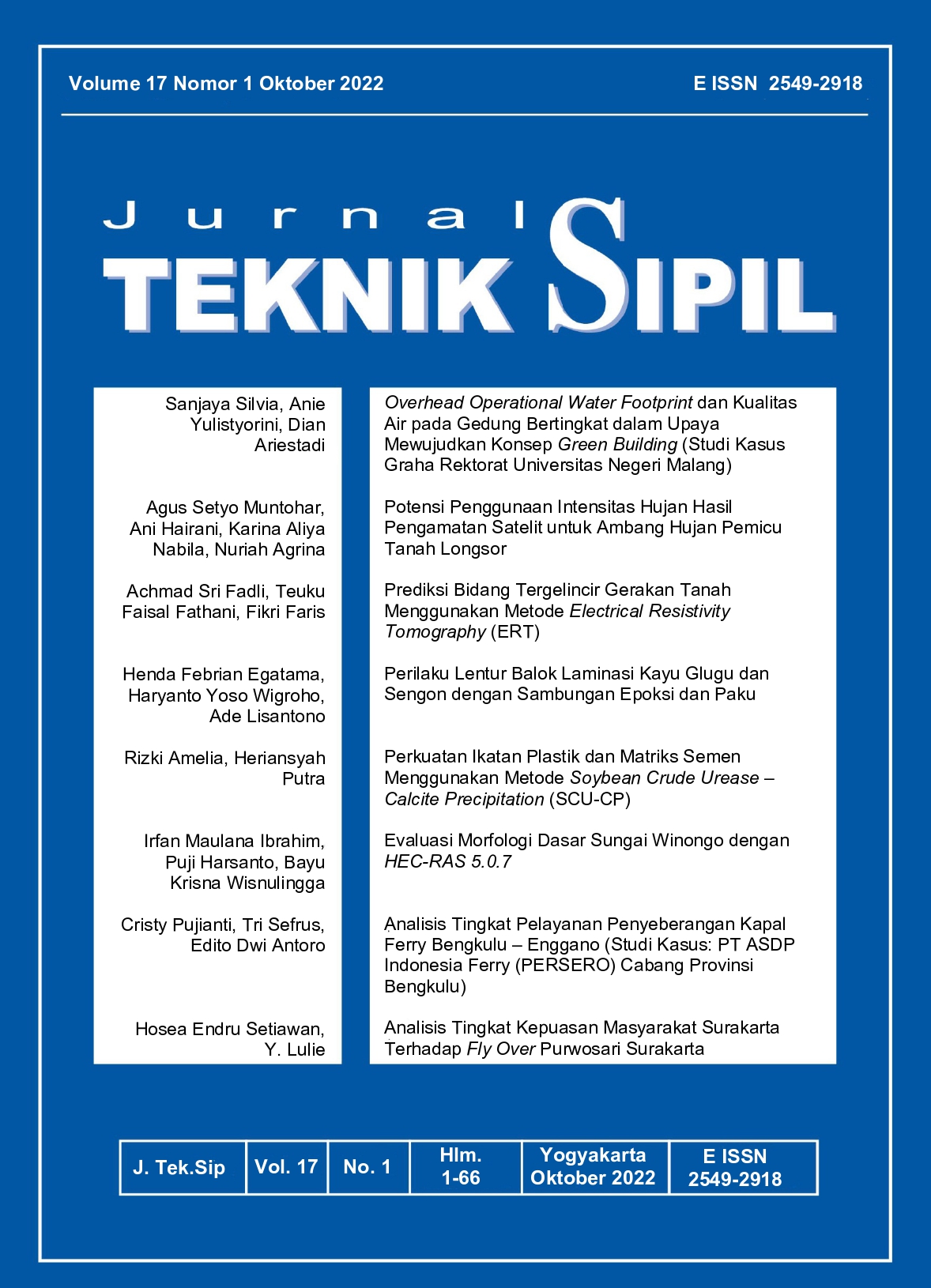OVERHEAD OPERATIONAL WATER FOOTPRINT DAN KUALITAS AIR PADA GEDUNG BERTINGKAT (STUDI KASUS GRAHA REKTORAT UNIVERSITAS NEGERI MALANG)
DOI:
https://doi.org/10.24002/jts.v17i1.5145Abstract
Graha Rektorat Building at the State University of Malang (UM) significantly contributes to water usage. Water usage in the building must be managed and appropriately considered, so it can highly contribute to UM's ranking of UI Green Metric for water conservation indicators. Water usage can be calculated by analysis of overhead operational water footprint. This research aims to analyse green, blue, and grey water footprint, overhead operational water footprint, and the quality of green water on the Graha Rektorat building. The methods used in this research are the quantitative method. This research showed the blue water footprint, green water footprint, and grey water footprint of Graha Rektorat building each by 5628 m3 during January – September 2021, 4361.43 m3/year 18.575 m3/day. Overhead operational water footprint on Graha Rektorat building equal with the value of blue water footprint which is 5628 m3 during January – September 2021. The quality of green water on the Graha Rektorat building does not meet the requirements of Indonesian Minister of Health No. 32 of 2017 concerning environmental health quality standards and water health requirements for hygienic and sanitation purposes. Swimming Pools, Solus Per Aqua, and Public Baths, so as another alternative, green water can be used as a substitute for flushing toilets and watering plants to reduce blue water usage.
References
Asnaning, A. R., Surya, & Saputra, E. (2018). "Uji Kualitas Air Hujan Hasil Filtrasi untuk Penyediaan Air Bersih Rainwater Quality Test From Filtration Result for Clean Water Supply". Prosiding Seminar Nasional Pengembangan Teknologi Pertanian VII Polinela.
BPS. (2019). Badan Pusat Statistik 2019.
Budiman, M. E. (2017). "Water Footprint Produksi Gula Tebu". Jurnal Rekayasa, Teknologi, Dan Sains, 1(2), 120–131.
Chaniago, E. A. (2017). Pemeriksaan Bakteri Escherichia coli pada Beberapa Sampel Air Bersih yang Diambil di Laboratorium Mikrobiologi BTKL-PP Kelas 1 Medan.
Hoekstra, A. Y., Chapagain, A. K., Aldaya, M. M., & Mekonnen, M. M. (2009). Water Footprint Manual State of the Art 2009 (Issue January).
Idhar, C., & Yuwono, B. E. (2019). "Analisis Potensi Peningkatan Sertifikasi Green Building terhadap Konservasi Air Gedung Waskita". September, 99–102.
Peraturan Menteri Kesehatan Republik Indonesia Nomor 32 Tahun 2017 tentang Standar baku Mutu Kesehatan Lingkungan dan Persyaratan Kesehatan Air untuk Keperluan Higiene Danitasi, Kolam Renang, Solus Per Aqua, dan Pemandian Umum. (n.d.).
Peraturan Menteri Lingungan Hidup dan Kehutanan Republik Indonesia Nomor:P.68/Menlhk/Setjen/Kum.1/8/2016 tentang Baku Mutu Air Limbah Domestik. (n.d.).
Pradana, M., & Reventiary, A. (2016). "Pengaruh Atribut Produk Terhadap Keputusan Pembelian Sepatu Merek Customade (Studi di Merek Dagang Customade Indonesia)". Jutnal Manajemen, 6(1), 1–10.
Sari, M., & Huljana, M. (2019)." Analisis Bau , Warna , TDS , pH , dan Salinitas Air Sumur Gali di Tempat Pembuangan Akhir". Jurnal Ilmu Kimia Dan Terapan, 3(1), 1–5.
Wang, L., Ding, X., & Wu, X. (2013). "Blue and grey water footprint of textile industry in China". Water Science and Technology, 68(11), 2485–2491. https://doi.org/10.2166/wst.2013.532
Widiyanto, A. F., Yuniarno, S., & Kuswanto. (2015). "Polusi Air Tanah Akibat Limbah Industri dan Limbah Rumah Tangga". Jurnal Kesehatan Masyarakat, 10(2), 246–254.
Yulistyorini, A., Puspasari, A. K., Mujiyono, & Sari, A. A. (2019). "Removal of BOD and TSS of Student Dormitory Greywater using Vertical Sub-Surface Flow Constructed Wetland of Ipomoea Aquatica". IOP Conference Series: Materials Science and Engineering, 515(1). https://doi.org/10.1088/1757-899X/515/1/012056


